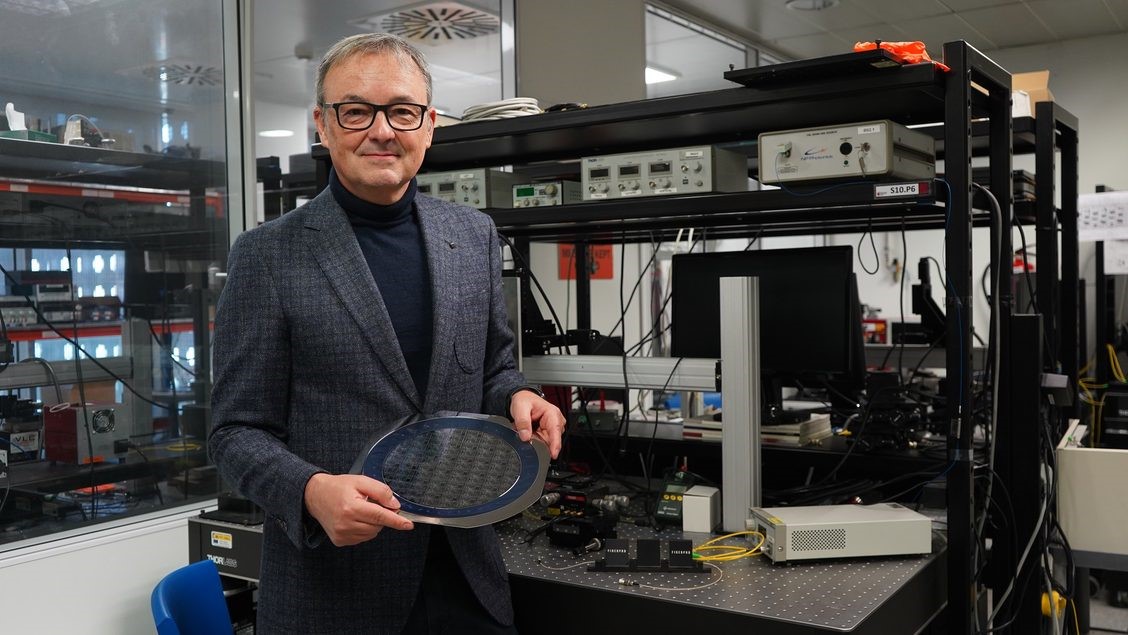The head of the Photonics Research Labs-iTEAM , José Capmany Francoy, has obtained an ERC Advanced Grant –the most prestigious grant from the European Research Council– endowed with 2.5 million euros for the development of the ANBIT project.
The aim of this ERC project is to develop an entirely new class of computation theory, termed Analog Photonic Computation (APC), specifically designed to exploit the full potential of programmable integrated photonics technology, which will have a profound impact on fundamental and applied research and on our information society.
“For over 5 decades, Moore’s scaling law has enabled the growth of device integration in electronic circuits at a steady rate, where the number of transistors incorporated in a chip has approximately doubled every 18-24 months. At present, this empirical law has already shown signs of saturation. Hence, an opportunity appears in the exploration of new strategies, that aim to maintain the sustainable growth of digital computing capability by developing new models of computation (e.g., quantum computing) which can solve problems that are not efficiently executed using digital computing”, states José Capmany.
The UPV-PRL researcher explains that this new computing theory, called analogue photonic computing, revolves around the idea of performing analogue operations on a new unit of information, the analogue bit or anbit. This evolves the concept of optical analogue signal processing into true optical analogue computing and represents a breakthrough with a similar potential to digital computation theory in commercial electronics.
Second Advanced Grant in six years
The ERC Advanced Grant funding is amongst the most prestigious and competitive EU funding schemes, providing researchers with the opportunity to pursue ambitious, curiosity-driven projects that could lead to major scientific breakthroughs. They are awarded to established, leading researchers with a proven track-record of significant research achievements over the past decade. The European Research Council (ERC) announced the awarding of 218 Advanced Grants to outstanding research leaders across Europe, as part of the Horizon Europe programme, 16 of them in Spain. It is also worth noting that it is the second time that Professor Capmany has obtained this prestigious recognition, for he also received another Advanced Grant (UMWPChip) for the development of the first photonic integrated chip that enables multiple functionalities by employing a single common architecture, in 2017.
“For me, receiving this new ERC is an enormous privilege that recognizes the excellent work done by our research group in recent years, which has not only materialized in high-level publications, but also in the creation of several spin-offs that are bringing new concepts to the market”, highlights Capmany. This ERC Grant will allow him and his team to work on this new Analog Photonic Computation concept for the next five years.
The limitations of Electronic Digital computing
Electronic Digital computing is indispensable today. You can find it in computers, trains, and planes, in your car, mobile phone, and smart watch, and in your household appliances. “For example, your washing machine needs digital electronic computing to execute the washing program selected by the user. Therefore, Electronic digital computing is a cornerstone of our society. However, it exists fundamental mathematical limitations of current digital computation theory (constructed from irreversible nonlinear Boolean gates) to efficiently perform multi-dimensional linear operations and computational problems that are distributed, parallel, and adaptive. As a result, a large gamut of applications cannot be supported by digital electronics, specifically, those that involve real-time analogue multidata processing, e.g., medical diagnostic imaging, autonomous cars, drug design and robotic control, among others.”, explains José Capmany.
On the other hand, electronic technology tries to overcome the mathematical limitations of digital computing by integrating more and more transistors on chips to increase computing speed. “However, the ability to double the number of transistors on a chip every two years, known as Moore’s law, has come to an end. For that reason, the electronics industry will be less and less capable of increasing the computing speeds required by emerging applications”, points out Capmany.
Analog photonic computing, the solution
Historically, mathematical models have been developed first, and then technology had to adapt to the already existing mathematics.
“But… what would happen if instead of developing the technology to fit in existing mathematics, we did it the other way around? With ANBIT we will establish the foundations of a new class of computing theory explicitly designed to exploit the full potential of programmable integrated photonics, a fast-growing technology that can complement electronics, and for which there is no specific computational model developed. This is the basis of our work for the next five years, a ground-breaking proposal with which, if we are successful, we will contribute to a new revolution in information technology and society”, concludes Capmany.
Source: https://www.upv.es/noticias-upv/noticia-14051-erc-advanced-g-en.html

